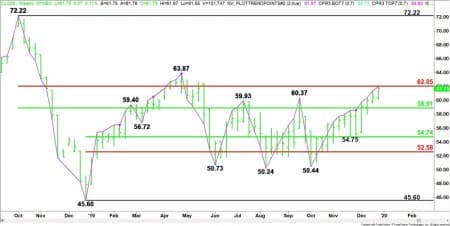During this Christmas-holiday shortened trading week, U.S West Texas Intermediate crude oil is set to finish the year in a strong position to continue the rally into early 2020. Although the market has been on a tear since the week-ending October 25, it was the three bottoms the week-ending June 7, August 9 and October 4 that saved this market from revisiting the lows in the $40’s hit on Christmas Eve 2018.
Generally speaking, the bullishness this year has been fueled by a number of factors including progress on Brexit, the U.S./China trade front and continued strength in the U.S. economy. Specifically, it was a pair of well-timed decisions by OPEC and its allies to reduce then deepen production cuts that helped stabilize prices. Ultimately, it was likely the actions by the U.S. Federal Reserve that helped stave off a steep break and return to last December’s major low.
At the end of 2018, crude oil prices were plunging as recession fears reached a fever pitch amid the combination of tariff tensions, Fed policy tightening, and a downdraft In U.S. manufacturing. Fourth-quarter GDP growth had slipped to nearly 1.0% from close to 3.0% the quarter before, with Purchasing Manager Index surveys sharply lower.
This year is ending with the economy strengthening on the back of continued labor-market strength and receding tariff threats dampening recession calls. GDP growth is now hovering near 2.4%, unemployment is at a 50-year low and wages are rising.
From…
During this Christmas-holiday shortened trading week, U.S West Texas Intermediate crude oil is set to finish the year in a strong position to continue the rally into early 2020. Although the market has been on a tear since the week-ending October 25, it was the three bottoms the week-ending June 7, August 9 and October 4 that saved this market from revisiting the lows in the $40’s hit on Christmas Eve 2018.
Generally speaking, the bullishness this year has been fueled by a number of factors including progress on Brexit, the U.S./China trade front and continued strength in the U.S. economy. Specifically, it was a pair of well-timed decisions by OPEC and its allies to reduce then deepen production cuts that helped stabilize prices. Ultimately, it was likely the actions by the U.S. Federal Reserve that helped stave off a steep break and return to last December’s major low.
At the end of 2018, crude oil prices were plunging as recession fears reached a fever pitch amid the combination of tariff tensions, Fed policy tightening, and a downdraft In U.S. manufacturing. Fourth-quarter GDP growth had slipped to nearly 1.0% from close to 3.0% the quarter before, with Purchasing Manager Index surveys sharply lower.
This year is ending with the economy strengthening on the back of continued labor-market strength and receding tariff threats dampening recession calls. GDP growth is now hovering near 2.4%, unemployment is at a 50-year low and wages are rising.
From a trade standpoint, sentiment has rapidly improved since the United States and China reached a Phase One trade agreement in mid-December. Investors are more optimistic about the economy and future demand growth as tariffs have been postponed and reduced.
Some traders blame the Fed for triggering last year’s steep break by raising interest rates too quickly. However, it was probably the Fed’s tightening combined with trade worries that weakened the economy enough to cause all the recession anxiety.
However, if one is going to blame the Fed for driving crude oil prices lower, then the central bank policymakers should get some credit for recognizing the slowdown in the economy then precisely timing three consecutive rate cuts in July, September and October to get the economy back on track.
With a recession in the rear-view mirror and the Fed stepping to the sidelines, it looks as if 2020 will feature further economic expansion. Additionally, the combination of increased demand growth and the OPEC-led production cuts should be the catalysts underpinning prices at least through the first quarter of 2020.
Technical Analysis
Weekly February West Texas Intermediate Crude Oil Technical Analysis

Weekly Trend indicator
The main trend is up according to the weekly swing chart. The uptrend continued this holiday-shortened week when buyers drove through last week’s high. This marked the 10th consecutive week the market has posted a higher-high than the previous week. This is a sign of steady buying and investor willing to buy strength rather than wait for pullbacks.
A trade through $63.87, the main top from the week-ending April 26, will reaffirm the uptrend. A trade through the last swing bottom from the week-ending October 4 at $50.44 will change the main trend to down.
A change in trend is extremely unlikely, however, due to the size and duration of the current rally, the market is vulnerable to a closing price reversal top. This higher-high, lower-close chart pattern usually indicates the selling is greater than the buying at current price levels.
It doesn’t mean that the trend is changing to down, but often means the market is overbought and needs to experience a short-term correction in order to alleviate some of the upside pressure.
The closing price reversal top is mostly likely going to be the chart pattern that stops the rally.
Weekly Retracement Levels
The main range is $72.22 to $45.60. Its retracement zone at $58.91 to $62.05 is currently being tested. This zone is controlling the longer-term direction of the market. Crossing to the strong side of this zone will indicate the buying is getting stronger. This move will also solidify the current upside bias, and could trigger an acceleration to the upside.
The minor range is $45.60 to $63.87. Its retracement zone at $54.74 to $52.58 is support. Overcoming this zone the week-ending October 25 helped launch the start of the current rally.
Weekly Forecast
Based on the price action the week-ending December 27, the direction of the February WTI crude oil market the week-ending January 3, will be determined by trader reaction to the main Fibonacci level at $62.05.
Bullish Scenario
A sustained move over $62.05 will indicate the presence of buyers. If this move generates enough upside momentum then look for the rally to possibly extend into the main top at $63.87. This top, formed the week-ending April 26, is the high of the year. Taking it out with strong rising volume could trigger an acceleration to the upside.
Bearish Scenario
A sustained move under $62.05 will signal the presence of sellers. These traders will be essentially stopping the market from rallying any further. They could be profit-takers or short-sellers.
If the sellers are profit-takers then plan on a short-term correction into a value area like the main 50% level at $58.91. Profit-takers tend to feel that a market is over-priced and due for a break into a more attractive price. The move will also signal trader unwillingness to buy strength.
If the sellers are getting short then they will be playing for a much larger break. They could be hedgers locking in a favorable price or speculators looking to regain control of the market and drive prices much closer to major support areas like $54.74 to $52.58.


















